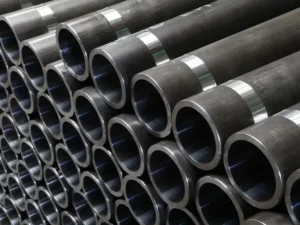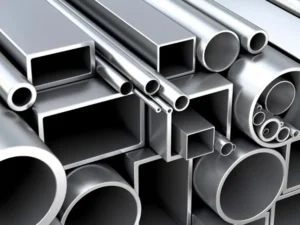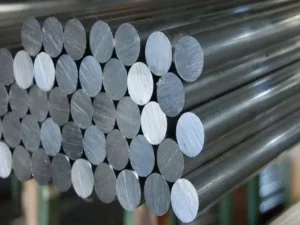According to the World Steel Association, our world produced 1878 million tons of crude steel in 2020. These are huge numbers, and scientists have discovered many different types of steel having distinct physical and chemical compositions.
Each type of steel has different strength, durability, and overall properties. This guide will explore various types of steel and its grading system. Whether you are a student or an experienced engineer, this article will be equally important to all.
Introduction to Steel
In the most straightforward words, steel is made mainly by combining iron and carbon. However, there are some other impurities and elements present in the steel. These impurities and elements, including iron and carbon, affect the properties of steel.
As I said earlier, steel is one of the most produced elements in our world. The reason is that it is versatile, powerful, and durable. Steel has found its way from our utensils to more prominent manufacturing companies. Thanks to its versatile composition and properties.
You can imagine the versatility of their composition by the fact that there are more than 3500 steel grades. Each of those grades has a different physical and chemical composition. All those steel grades are used for various purposes at the industry level.
Steel is so good due to the presence of carbon in it that adds hardness. One of the exciting things is that steel is not very expensive. Hence, it is a viable option for engineers to use in buildings and other industries such as automotive and aerospace.
Types of Steel
As I said, there are many types and grades of steel. However, there are a few types that account for most of the steel that is being used in today’s world. I will discuss those types in the section below and help you understand them.
1- Carbon steel

It is also known as mild steel and is the most common type. Many industries use it to produce a variety of products. The reason behind its extensive usage in different sectors is its durability and robustness. There are various types of carbon steel, and each type offers different usability due to its chemical composition.
- Low-carbon steels: This type of carbon steel is very soft and sensitive as it contains less carbon (up to 0.3%). It is also known as mild steel The engineers use this to make sheets and other stuff. Pressure is applied to this steel and converted into plates and other stuff.
- Medium carbon steel: It is more robust than low carbon steel and contains more carbon (0.3 – 0.6%). The good thing about this type is that it offers excellent durability. Due to its strength and hardness, it is used in the automotive industry.
- High-carbon steel: The heavy-duty industry’s most vital carbon steel type. It contains Cobain ranging from 0.6% to 2.1%. Their usage is diverse, and engineers use them where they require strength, such as building.
The distinction between mild and carbon steel lies in their carbon content. Their differences in carbon content give them different mechanical properties. Mild steel is softer and more ductile than sturdier carbon steel.
2- Alloy steel
As the name suggests, this type of steel is present in the alloy. It is made by mixing the steel with other elements such as chromium and nickel. These alloy steels are well known for their resistance against rust and corrosion.
The other element added to the steel stops iron oxide (rust) when it contacts oxygen. For example, suppose the steel is mixed with chromium. In that case, chromium reacts with oxygen to form chromium oxide instead of allowing the steel to make iron oxide. The chromium oxide layer does not rust and protects the steel from corrosion.
Here is a list of other elements that can be used in alloying with steel.
| Element | Properties |
| Copper | Electrical conduction |
| Nickel | Strength, toughness, corrosion resistance |
| Silicon | Magnetic properties, deoxidizer |
| Cobalt | Heat resistance, cutting capabilities |
| Aluminum | Lightweight, high-temperature resistance |
| Molybdenum | High-temperature strength, corrosion resistance |
Each of the elements offers different properties. The cobalt steel alloy will provide excellent heat resistance. Similarly, the molybdenum steel alloy will offer excellent temperature-bearing capacity. So, every alloy made with this element will have a different specialty.
3- Stainless steel

Stainless steel consists of at least 10.5% of chromium in it. As mentioned above, chromium offers a unique feature of making chromium oxide when it reacts with oxygen. So, when you make a product with stainless steel, it does not get rust due to this chromium oxide layer.
The chromium oxide layers do not appear at the surface of stainless steel and remain invisible. However, It does not allow the iron present in the steel to react with oxygen to form an iron oxide layer (rust or corrosion). This type of steel is used to make rust-proof products.
Quick Note: Keep in mind that alloy and stainless steel are different. Their properties and applications also vary. You can read a detailed comparison in our alloy vs. stainless steel guide.
4- Coated Steel
In this type, the engineers apply a coat on the steel, which keeps it solid and safe from rusting. For example, if the manufacturer makes something that will be used in moist conditions, he applies a thin coat.
The coating will not allow the iron oxide layer and keep the steel in good shape for the years to come. The simplest example of coated steel is applying a thin layer of paint to make it look beautiful and keep it safe from rust and UV radiation.
5- Tool steel

The tool steel is well known due to its heat-bearing capacity. It indicates that this type of steel is also solid. Usually, it is used to make tools and equipment such as drills and saw blades. This equipment can withstand solid temperatures and quickly wear abrasive.
Different elements can be used with steel to make tool steel. However, tungsten, chromium, and vanadium are some of the most used aspects of tool steel. Keep in mind that there are countless types of steel. Keep in mind that there are myriad types of steel.
Other types include spring, galvanized, high-speed, weathering, and electrical steel, but discussing them all is impossible. Moreover, these types are not famous and account for minimal steel.
Steel Grading Systems
As said earlier, thousands of different types of steels vary in chemical composition and properties. With a well-organized system for their classification, studying and analyzing them becomes possible.
So, the scientists have made a complete grading system. This system offers each type a specific grade depending on its chemical composition and properties. With these grading, it is easier for scientists and government agencies to recognize the type easily.
Each type has its grade and usability. So, if a scientist creates something requiring a specific style, he will use the assigned grade. This universal grading system has made understanding and analyzing different steel types easy.
Two grading systems are currently being used worldwide. I will discuss how those two grading systems differ in the section below.
1- SAE Grading System
The American Iron & Steel Institute (AISI) and the Society of Automotive Engineers (SAE) introduced the SAE grading system. It classifies the steels based on their chemical composition. It is also known as a four-digit numbering system. The reason is that this system assigns four numbers to each type of steel.
Here is the breakdown of those four numbers that this grading system assigns:
1- First Number
The first number represents the alloy element present in a higher amount. In other words, it indicates the primary alloy element. For example, one means that carbon is present in alloys made of steel. Similarly, two means that two nickel is present as the primary alloy with steel. The list goes on. Here are the numbers for other alloying elements.
| First Number | Alloying Element(s) |
| 2 | Nickel steels |
| 3 | Nickel-chromium steels |
| 4 | Molybdenum steels |
| 5 | Chromium steels |
| 6 | Chromium-vanadium steels |
2- Second Number
The second number in the SAE grades indicates the amount or the concentration of alloying elements present with the steel. By seeing the second number of any steel, the scientists immediately understand the chemical composition of that steel type.
3- Third and Fourth Numbers
The third and fourth numbers in the steel type indicate the concentration of carbon in it. It is usually expressed in hundredths of a percent. For example, in 1020 steel, the concentration of carbon will be 0.20%
2- ASTM Grading System
The ASTM grading system is considered more reliable and comprehensive. Unlike the SAE grading system, it is based on different factors such as steel’s chemical, physical, and mechanical properties. This grading system is easy to understand.
In ASTM grading, the material is assigned a letter prefix. It can be anything from A to Z. After this letter comes a number. This number indicates a specific set of rules explaining the material’s properties, behavior, production, and usability.
For example, the letter A represents ferrous metals. Similar letter B indicates nonferrous metals. The list goes on. The number shows the set of rules that the scientist has already set in the ASTM grading system.
Is Steel Environmentally Friendly and Sustainable?
Steel production by traditional means is used to produce CO2 that is emitted into the environment. The emission of CO2 was dangerous as it used to act as a greenhouse gas and affect overall climate change. However, things have changed now.
Modern steel-making technologies use electric arc furnaces (EAF) that do not emit much CO2, making the whole steel production process environment-friendly. Moreover, steel is easily renewable.
The arc furnaces don’t utilize the iron ore to prepare steel. Instead, it uses scrap metal as the raw material. When it does not utilize iron ore, it does not emit carbon dioxide gasses that could cause environmental pollution.
As far as sustainability is concerned, steel is renewable. No matter how long you recycle steel, its shape, and overall value remain the same. Above all, recycling steel is quick; you can get it more quickly.
Another essential thing that indicates sustainability is the energy requirement for steel production. The exciting thing is that its output takes less energy. For instance, you’ll need only 40% of the energy required in 1960 to produce one ton of steel.
This state shows that the energy requirement for producing steel is decreasing over time. It is a green signal that the production of steel is sustainable. Due to the usage of modern technologies, the emission of dangerous gasses has also been controlled, which is another plus.
Conclusion
Steel is versatile, and it is helpful in almost every industry. Is there any field of life where we don’t use steel? I don’t think so. The good thing is that it is being produced on a large scale. New and different types are coming into existence, which will be good for the future.
Above all, the production process is not bad for the environment, which is a big plus. In this guide, I have explained the types of steel and the grading system that assigns grades and classifications for different kinds of steel. Hopefully, it proves to be helpful!
